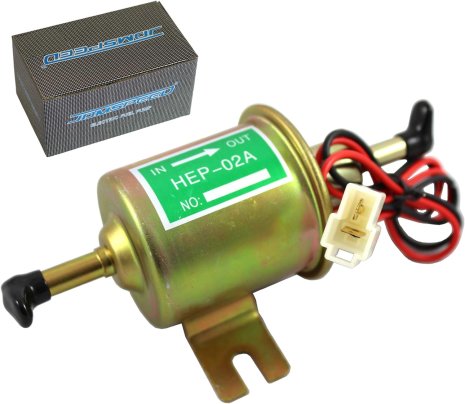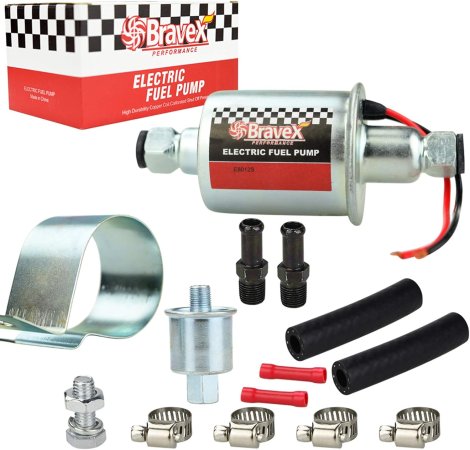We may earn revenue from the products available on this page and participate in affiliate programs. Learn more ›

Fuel delivery is essential to making an engine run. It doesn’t matter if you’re trying to breathe new life into a carbureted big block or get the lawn equipment moving, the engine needs a steady supply of fuel, and that’s precisely what a fuel pump is for. If you’re dealing with most classic designs, you’ll have the option to work with the mechanical or electric pump.
There are many reasons to stick with the mechanical pump, and they stem beyond merely keeping the vehicle as it was when it rolled off the show room floor. But this guide is all about electric pumps to help you choose one for your application. We list some of our favorites to keep things as simple as possible.
Benefits of Electric Fuel Pumps
- Availability. It’s no secret that parts fail. If you’re working on a vehicle that you rely on, it is wise to run the pump style that’s most readily available to you. Investing in spare parts is a way around this, but you’re far more likely to find a universal pump at the local parts store in many cases.
- Higher flow rates. If you’re dealing with high power levels or a fuel injection swap, higher fuel rates are essential. There are mechanical pumps that can supply the necessary fuel flow, but electric pumps with the same capacity are often easier to install and are more readily available.
- Safety. The factory location of a fuel pump can be a call for concern. They almost exist near the exhaust manifold or header. The residual heat can cause vapor lock or boil fuel in the system, which may lead to a fire. The use of an electric pump is one way around these issues.
- Efficiency. Electric fuel pumps have an edge in terms of efficiency because they overcome some of the issues a mechanical pump struggles with. That said, they don’t boost engine efficiency but help to create an optimized fuel delivery system. If you’re interested in learning more about fuel delivery, you should check out our reviews of Most Fuel-Efficient Cars and What is Flex Fuel to get up to date.
Types of Electric Fuel Pumps
Inline
An inline fuel pump is a style that exists in the fuel lines between the engine and the fuel tank. One of the advantages of this style of pump is the ease of installation and maintenance. But because they are meant to push rather than pull, you have to find or fabricate a location to mount the pump, so it doesn’t have to work too hard to pull fuel from the tank. Locating it as low and near as possible is ideal as it will use gravity to its advantage.
In-Tank
In-tank pumps are precisely that, fuel pumps that live within the fuel tank or fuel cell. They are more costly than an inline pump but do many things better. For one, they don’t create the issue of finding a proper mounting location but you may need to update your tank to accept one. They also won’t starve as quickly under acceleration or low fuel levels. These pumps are generally much more powerful and meant to work with fuel injection systems. And because they exist within the tank, they make for a much better-looking final product. Our guide to Fuel Pumps has an emphasis on OE style pumps of this configuration and is worth the read for those who need a new fuel pump for late-model applications.
Top Brands
Holley Performance
Holley is based out of Bowling Green, Ky., and has been hard at work since 1903. If you know anything about classic American cars, you know Holley is a master of fuel delivery. The brand’s claim to fame may be carburetors, but the Holley (12427) Fuel Pump is an excellent example of its other offerings.
AEM Electronics
Headquartered out of Hawthorne, Calif., AEM Electronics is a known supplier of racing solutions. The company has been in the business of supplying racing components since 1987. It is in the business of outperforming the competition in any way possible. The AEM 50-1200 E85 In-Tank Fuel Pump is but one example of what it can do.
Carter
Since 1909, Carter has been hot on it with fuel delivery solutions. Over the years, it has been a leading supplier of components for fuel delivery systems. The company is headquartered in Rochester Hills, Mich., and produces fuel pumps of all shapes and sizes. And while we do love the Carter P4070 In-Line Electric Fuel Pump, it’s not all it has to offer.
Electric Fuel Pump Pricing
- $10-$50: Universal inline pumps dominate this price range. The further up you move in pricing, the quality will raise.
- $50-$100: In this price range, you can find a mix of inline and in-tank pumps. Depending on the style of pump, you can expect to see a fluctuation in quality and performance.
- $100 and up: Premium in-tank pumps dominate this price range. Depending on performance and features, you can expect to see these pumps climb well above the $100 mark.
Key Features
Mounting Type
It may seem obvious, but one of the most essential features of an electric fuel pump is its intended mounting configuration. Whether you want to mount something in the tank or outside of the tank does come down to a balance of performance demands and personal preference. How powerful an application is, whether it has a carburetor or fuel injection, and your budget all come into play when deciding what to install and run.
Flow Rate
The rate at which a pump supplies fuel is significant. How much is appropriate depends on power output and the type of fuel delivery system you’re working with. In all cases, a carbureted system requires a low-pressure pump, unlike fuel injection, which relies on high rates of fuel flow. You need to select a pump with a flow rate that matches the needs of your engine.
Other Considerations
- Fuel Compatibility. Gasoline isn’t the only thing an engine will run on. Even though our guide is more tailored to someone working with a relatively stock to mild applications, different fuel types are still a concern. For example, if you intend to use E85 in your application, you need to make sure the fuel pump will allow it. Otherwise, you may damage it.
Best Electric Fuel Pumps Reviews & Recommendations 2021
Best Overall
AEM 50-1000 High Flow In-Tank Fuel Pump
Best Value
JDMSpeed Universal 12V Heavy Duty Electric Fuel Pump
Premium Pick
AEM 50-1200 E85 In-Tank Fuel Pump
Best for Small Equipment
Yoneda Low Pressure Inline Fuel Pump
Honorable Mention
Carter P4070 In-Line Electric Fuel Pump
Honorable Mention
Yoneda Electric Fuel Pump
Honorable Mention
Holley (12427) Fuel Pump
Honorable Mention
Brave Performance E8012S Universal Electric Fuel
Honorable Mention
u0026nbsp;Deal Auto Electric Parts Electric Intank Fuel Pump
Honorable Mention
Megaflint+ E8012S 12V Universal Electric Fuel Pump
Tips
- If you’re running an inline pump, keep in mind that it is meant to push fuel. It is essential to mount it as close to the gas tank and as low as possible to avoid damaging it.
- If you’re running an electric pump with a carburetor, you should install a pressure regulator. Doing so maintains ideal fuel pressure and prevents it from starving or flooding over.
- An electric fuel pump relies on fuel to lubricate and cool the internal workings. Therefore, you never want to let it run dry. An electric fuel pump relies on fuel to lubricate and cool the internal workings. Therefore, you never want to let it run dry. Consider reading our guide to Bad Fuel Pump Symptoms to prepare for incase the fuel system does begin to fail.
FAQs
Q: Is an electric fuel pump better than a mechanical pump?
An electric pump does solve a few issues a cam-driven pump cannot and is necessary for many applications. But a mechanical pump can offer ample fuel flow and better reliability than a similarly priced electric pump can.
Q: Can you use an electric fuel pump with a carburetor?
Absolutely. Many electric pumps are designed to work with a carbureted application. You just need to verify that it is and match the fuel flow rate to the demand of the carburetor.
Q: Where is the best place to mount an electric fuel pump?
You must mount an inline pump as close to the fuel tank and as low as possible. These designs are meant to push fuel. So it is essential to eliminate as much distance to the fuel supply as possible while allowing gravity to aid in delivery to the pump.
Final Thoughts
Again, our top pick goes to the AEM 50-1000 High Flow In-Tank Fuel Pump. Trying to sum up all we love about it in just a few words is tough, but it’s ultimately an ideal option for almost anyone who is converting from a carburetor to fuel injection. The JDMSpeed Universal 12V Heavy-Duty Electric Fuel Pump is in an entirely different league, but it’s still the best pump you can get at the lowest price possible. Let us know what your setup is and what pump you’re going to run!













